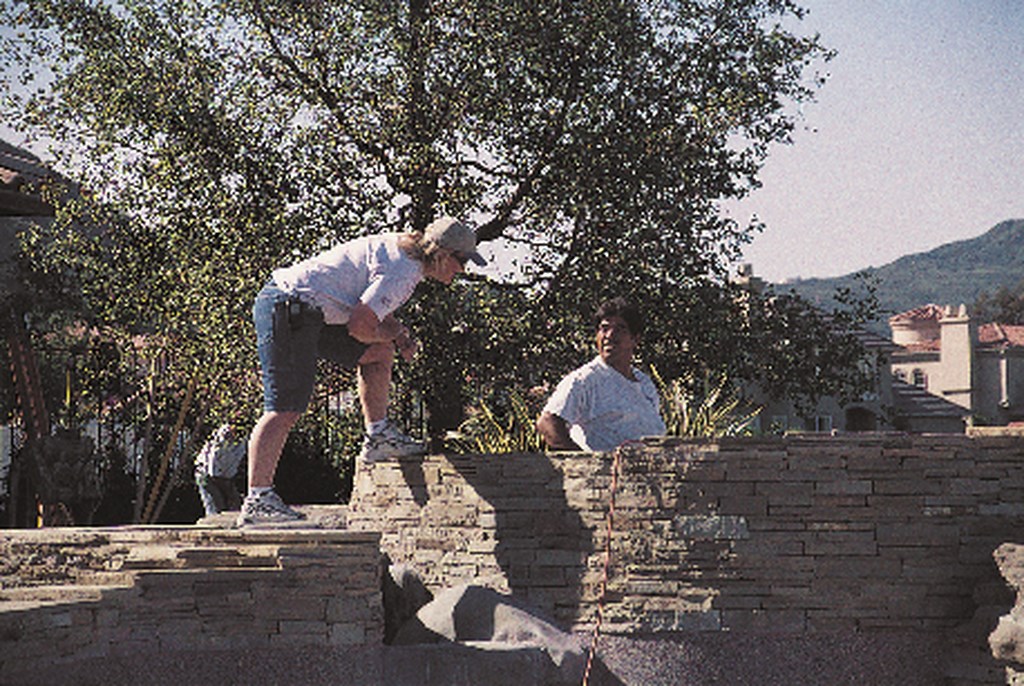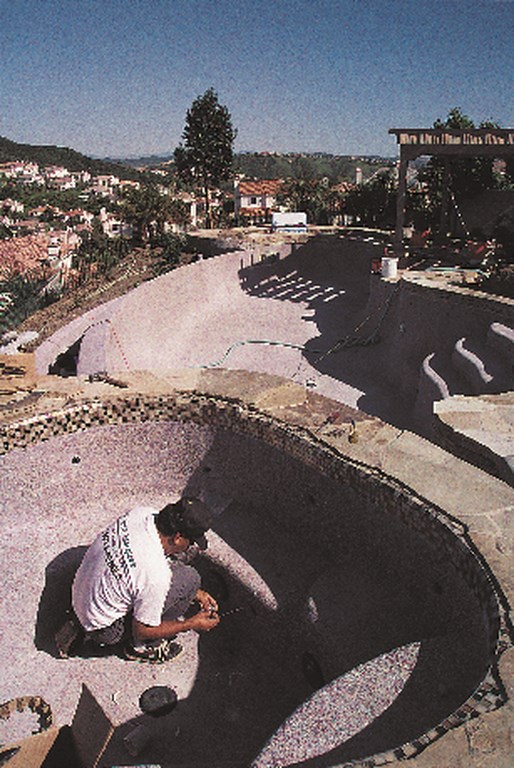Stretching Out the Hand-Off

As with every other step along the path of true quality in watershape construction, a good start-up is critical – a key transitional step requiring supervision, teamwork and passion for the work.
This is the point where a watershaper’s vision becomes reality, where construction becomes maintenance and where the clients’ dream is finally realized. It’s another important detail, and getting it right requires complete trust and wide-open lines of communication among builder, service technician and homeowner.
That puts a premium on finding the best possible person in your area to take on the responsibility. In my case, I consider myself very fortunate to work with a true service professional, Kerri McCoy of Pineapple Pools in Malibu, Calif. Conscientious, thorough, dedicated and educated in the ways of high-quality construction, she’s the only person I currently work with in Southern California, where I do most of my jobs.
If you haven’t identified this person in your area, don’t hesitate to start looking: This relationship is far too important to leave to chance.
PART OF THE TEAM
I can rely on the fact that Kerri is as committed to quality as I am. I can count on her to take care of all the details, ask the questions that need to be asked and listen to the answers. Better yet, I can count on her to return my calls – and that’s important, because I talk to Kerri almost constantly, keeping her up to speed on the projects I’m doing.
The working relationship has become so close that she’s been involved from the start of most of my current projects, advising me on service issues and becoming very well versed in the many details of the “wet art” I’m creating.
When you build quality, the start-up technician is really part of the team. Kerri knows all of my subcontractors. She knows all about the materials I use, the equipment I choose, my philosophy of design and my commitment to quality. As the person who will start-up and maintain my art, she is well versed in almost all aspects of its design and construction from the project’s conception. She’s even accompanied me to presentation meetings with clients.
More often and in more practical terms, she gets involved in my projects during construction, when she has an opportunity to offer her input on specific issues such as equipment layout and configuration. This early acquaintance with the project also gives her time to watch and familiarize herself with the range of variables of weather, wind, plants and pets that will affect the service work she will perform later on.
By the time we’re finished with construction, she’s familiar with the electrical system, the control system, plumbing and hydraulics, any chemical treatment systems, visual features and all the spa specifics.
As I’ve said here many times, every setting is different, every client is different and every project is different. Knowing this, I’m particularly impressed by the incredible range of factors Kerri has to weigh in planning for service with respect to time, level of difficulty and pricing.
There’s another thing I like about working with her: Like all of the people I work with whom I most respect, she has a genuine passion for what she does. She wants to learn, she reads and studies and she won’t let anything slide. In fact, she has such a hunger for information and insight that she’s even attended the Genesis 3 Design School to learn more about design and watershaping.
She’s definitely not what I’d call a “pool grunt.” If she hasn’t found things out by herself, she’ll ask me dozens of questions about my clients and the setting, the number of children, nearby trees, animals, prevailing winds and sun exposures. In time, she understands all there is to understand – and how to meet the clients’ needs and desires. All of this informs the way she structures and plans her service routines.
A CLEAN HAND-OFF
On most jobs, she’s so involved (and by the time I wrap up my work, so familiar to the clients) that it’s a foregone conclusion that she’ll stay on as regular service technician when I’m gone. It’s also a fact that, in all my years of building quality watershapes, my recommendation about who should take care of the pool carries a lot of weight with my clients.
It also helps that starting up a pool is an exciting time for homeowners, who, after months of anticipation, are 100% ready to see their pool filled with water and operational. Obviously, it’s the point where you as designer and builder see how well things work both technically and aesthetically. It’s also a point in time where a trusted, creative, well-informed service technician on hand is extremely valuable.
It’s never a casual thing for me. At least a week before we’re to fill the pool with water, Kerri and I will meet on site and do a detailed walk-through of every single system, detail and piece of equipment. I hand over all the technical data on the equipment and system configurations. I reiterate with her all relevant information I have on the clients, including things such as pager and cell-phone numbers and e-mail addresses.
At the same time, she’s preparing to take over. She’ll check and recheck the equipment and figure out just what it’ll take to work with a given pool as part of her business (rather than as an observer). In other words, she’s taking “ownership” of the project – and with everything she does, she’s building my confidence that I’m leaving things in good hands.
As we prepare for the big day, she meets with the clients and discusses service scheduling and their programming preferences for the control systems. She’ll do the initial programming for them and also teach them how to use the system and answer any questions the might have.
This is important: By involving the service technician over a period of time in a true transition, I effectively remain in control of the pool’s operation. This is a key difference between my approach and that of others in the trade who leave responsibility for the start-up in the hands of the homeowners or a technician of their choosing.
Because this pool represents my commitment to quality, I don’t like even the thought of leaving homeowners on their own to destroy my work.
DOWN TO DETAILS
Immediately after the finish is applied (whether it’s plaster, pebbles or tile), it’s time to fill the pool – and this is exactly the point at which I hand control over to Kerri and step back into a supporting role.
As the pool fills, Kerri manages the chemical phase of the start-up and takes care of all the necessary brushing and cleaning. At this point, all the circuit breakers are off, and she’s in charge of activating all systems. If there’s any problem with any of the systems, she’ll call me and we’ll work things through together.
My subcontractors and I will make the necessary adjustments immediately. It’s Kerri’s game now, and I’ll do all I can (and insist my subs do the same) to make certain she’s in a position to satisfy homeowners who are now her clients.
This is another important point: A big mistake many people make in this business is that they allow certain issues to remain unresolved. This is always a negative from the clients’ point of view, so I’m glad to have Kerri on my team to help me speed things toward real, practical, long-term solutions. And because she’s so involved and familiar with the systems, we can respond almost immediately and implement changes very quickly to address any and all unforeseen problems that might arise.
As I’ve said before in this column, supervision and working with quality subcontractors are critical to achieving quality. I consider my service technician as being an extremely important member of that team.
What qualities should you look for in your service professionals? My advice first of all is to do everything you can to find a technician who is passionate about what they do. Just as important is finding one who understands construction and has a feel for how a project comes together. Finally, take your time: Just as it can take a while to find a good electrician, carpenter or plumber, you may have to dig a little and try out a few different people to identify your start-up specialist.
I’ve known builders who make the mistake of putting the job out of their mind once it’s over. That’s just crazy, because when you’re finished as designer and/or builder, that’s when the life of the watershape really begins. Speaking for myself, I never really consider that I’m “done” with a project: Through Kerri and my ongoing relationship with her, the watershapes I’ve built will be mine as long as the work exists and will always reflect my own passion for what I do.
Look at it this way: If you take what you do seriously, handing the work over to a service technician represents a massive leap of faith and trust. With so much riding on that relationship, it only makes sense to invest the time and effort needed to find the very best person you can.
David Tisherman is the principal in two design/construction firms: David Tisherman’s Visuals of Manhattan Beach, Calif., and Liquid Design of Cherry Hill, N.J. He can be reached at [email protected]. He is also an instructor for Artistic Resources & Training (ART); for information on ART’s classes, visit www.theartofwater.com.












